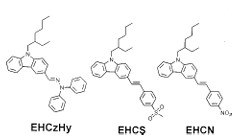Charge carrier mobility and photorefractive grating buildup in bipolar organic glasses
- 저자
- Jiwon Sohn, Jaehoon Hwang, Soo Young Park, Yong-Young Noh and Jang-Joo Kim
- 저널명
- Applied Physics Letters, 81, 190–192 (2002)
- 년도
- 2002
- Link
- https://doi.org/10.1063/1.1492312 505회 연결
[Abstract]
Two-component organic glasses consisting of photoconductive molecule, N8-@9-~2-ethylhexyl!-9H-carbazol-3-ylmethylene#-N,N-diphenyl-hydrazine ~EHCzHy!, and multifunctional photorefractive molecules, 9-~2-ethyl-hexyl!-3-@2-~4-methanesulfonyl-phenyl!-vinyl#-9H-carbazole ~EHCS! @ J. Sohn et al., Appl. Phys. Lett. 77, 1422 ~2000!# and 9-~2-ethylhexyl!-3-@2-~4-nitro-phenyl!-vinyl#-9H-carbazole ~EHCN!, were prepared, and their charge carrier mobility and photorefractive grating buildup were investigated. EHCzHy is a unipolar hole-transporting (mh54.1631026 cm2/Vs) molecule with no electro-optic property. EHCS and EHCN are nonlinear optical molecules with unipolar (mh52.4231026 cm2/Vs) and bipolar (mh 52.3031026 cm2/Vs,me52.8631026 cm2/Vs) carrier mobilities, respectively. Different behaviors of the photorefractive grating buildup in two-component organic glasses were investigated as a function of EHCN or EHCS content.
Two-component organic glasses consisting of photoconductive molecule, N8-@9-~2-ethylhexyl!-9H-carbazol-3-ylmethylene#-N,N-diphenyl-hydrazine ~EHCzHy!, and multifunctional photorefractive molecules, 9-~2-ethyl-hexyl!-3-@2-~4-methanesulfonyl-phenyl!-vinyl#-9H-carbazole ~EHCS! @ J. Sohn et al., Appl. Phys. Lett. 77, 1422 ~2000!# and 9-~2-ethylhexyl!-3-@2-~4-nitro-phenyl!-vinyl#-9H-carbazole ~EHCN!, were prepared, and their charge carrier mobility and photorefractive grating buildup were investigated. EHCzHy is a unipolar hole-transporting (mh54.1631026 cm2/Vs) molecule with no electro-optic property. EHCS and EHCN are nonlinear optical molecules with unipolar (mh52.4231026 cm2/Vs) and bipolar (mh 52.3031026 cm2/Vs,me52.8631026 cm2/Vs) carrier mobilities, respectively. Different behaviors of the photorefractive grating buildup in two-component organic glasses were investigated as a function of EHCN or EHCS content.
